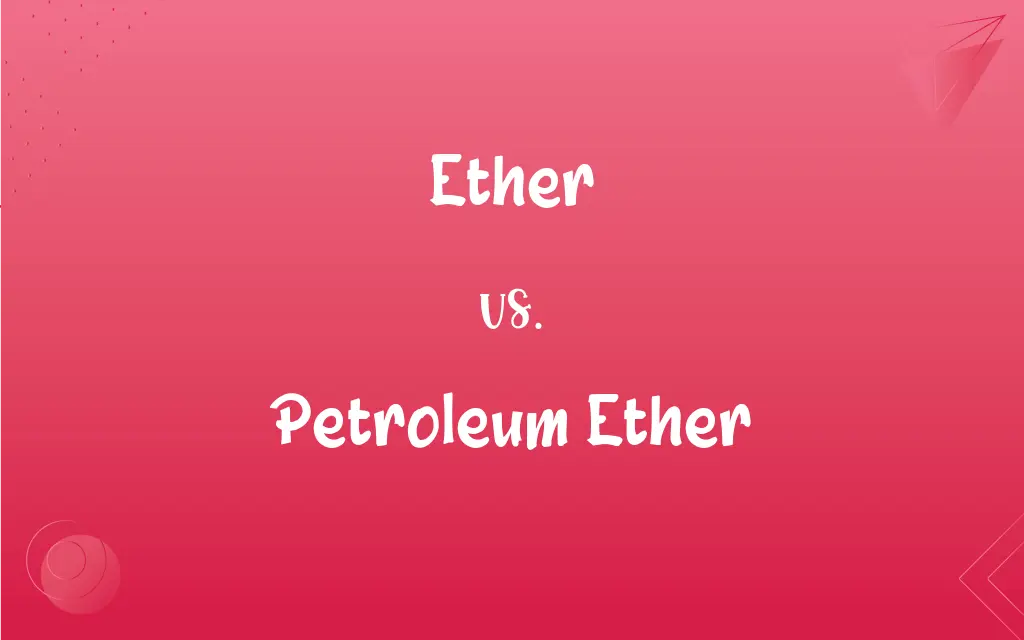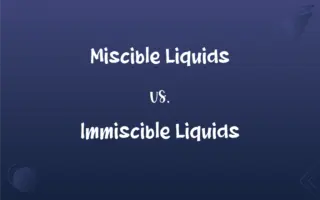Ether vs. Petroleum Ether: What's the Difference?
Edited by Aimie Carlson || By Janet White || Published on March 15, 2024
Ether is an organic compound with an oxygen atom connected to two alkyl groups, while petroleum ether is a mix of hydrocarbons used as a nonpolar solvent.

Key Differences
Ether, chemically known as diethyl ether, is an organic compound characterized by an oxygen atom bonded to two alkyl or aryl groups. It is well-known for its use as a solvent in laboratories and formerly as an anesthetic in medical settings. Petroleum ether, on the other hand, is not a single compound but a mixture of aliphatic hydrocarbons obtained from petroleum. It is used primarily as a nonpolar solvent in the purification and extraction of compounds in chemical processes.
The physical properties of ether include its distinctive ether smell, volatility, and its ability to dissolve a wide range of organic compounds, making it invaluable in organic synthesis and extractions. Petroleum ether, despite its name, contains no ethers and is a light, volatile fraction of petroleum with a low boiling point range. It is primarily used to dissolve nonpolar substances due to its nonpolar nature, differing significantly from ether in both composition and application.
Ether's reactivity includes its susceptibility to peroxide formation upon exposure to air and light, necessitating careful handling and storage. Petroleum ether, while less reactive than ether, still poses risks due to its flammability and potential health hazards if inhaled or ingested. The handling precautions for each solvent reflect their chemical properties and potential dangers in laboratory environments.
In terms of usage, ether's role extends beyond the laboratory as it was once a common anesthetic, although this use has declined due to safety concerns. Petroleum ether's use is more specialized, focused on its role as a solvent in laboratories and industries for extracting oils, fats, and other nonpolar substances. This distinction highlights the different niches each solvent occupies in scientific and industrial applications.
Both ether and petroleum ether are important solvents in their own right, their differences in chemical structure, properties, and applications underline the importance of understanding chemical nomenclature and properties in chemistry. The specific characteristics of each make them suitable for different tasks, emphasizing the need for precise selection based on the requirements of each chemical process.
ADVERTISEMENT
Comparison Chart
Composition
Organic compound with an O atom connected to two alkyl groups
Mixture of aliphatic hydrocarbons
Main Use
Solvent, formerly anesthetic
Nonpolar solvent in extractions
Chemical Properties
Volatile, can form peroxides
Highly flammable, low boiling point range
Applications
Organic synthesis, extractions, formerly in medicine
Extracting oils, fats, nonpolar substances
Reactivity
Susceptible to peroxide formation
Less reactive, but flammable
ADVERTISEMENT
Ether and Petroleum Ether Definitions
Ether
Formerly used as a general anesthetic.
Ether was one of the first anesthetics used in surgeries.
Petroleum Ether
Obtained from the distillation of petroleum.
Petroleum ether is produced during the refining process of crude oil.
Ether
Characterized by an oxygen atom linked to two alkyl groups.
The structure of ether facilitates its use as a solvent in organic chemistry.
Petroleum Ether
Features a low boiling point range.
The low boiling point of petroleum ether facilitates quick evaporation.
Ether
A volatile organic compound used as a solvent.
Ether is often used to dissolve organic substances in the lab.
Petroleum Ether
Highly flammable and requires careful handling.
Due to its flammability, petroleum ether must be handled with caution in the lab.
Ether
Known for its distinctive, sweet smell.
The smell of ether is unmistakable in the chemistry lab.
Petroleum Ether
A mixture of light hydrocarbons used as a nonpolar solvent.
Petroleum ether is ideal for extracting nonpolar compounds.
Ether
Prone to forming peroxides on exposure to air.
Special precautions are necessary to store ether safely.
Petroleum Ether
Used in the extraction of oils and fats.
To extract essential oils, petroleum ether is commonly used.
Ether
Any of a class of organic compounds in which two hydrocarbon groups are linked by an oxygen atom.
Ether
A volatile, highly flammable liquid, C4H10O, derived from distilling ethyl alcohol with sulfuric acid, used as a reagent and solvent, and formerly used as an anesthetic. Also called diethyl ether, ethyl ether.
FAQs
Why is ether no longer used as an anesthetic?
Due to its flammability and the development of safer anesthetics.
What is petroleum ether mainly used for?
As a nonpolar solvent for extracting oils, fats, and other nonpolar substances.
Can petroleum ether dissolve polar substances?
No, it is used to dissolve nonpolar substances due to its nonpolar nature.
Is ether the same as petroleum ether?
No, ether is a single organic compound, while petroleum ether is a mixture of hydrocarbons.
What are the safety risks of petroleum ether?
Its high flammability and potential health hazards if inhaled or ingested.
What is the boiling point range of petroleum ether?
Typically between 30 to 60 degrees Celsius, depending on the specific mixture.
How does ether's volatility affect its use?
It evaporates quickly, making it useful as a solvent but requiring careful handling.
How is ether stored to prevent peroxide formation?
In dark, air-tight containers, often with stabilizers to prevent peroxide formation.
What is ether commonly used for?
As a solvent in organic chemistry and formerly as an anesthetic.
How does the structure of ether differ from most hydrocarbons?
Ether contains an oxygen atom bonded to two alkyl groups, unlike hydrocarbons which are composed only of carbon and hydrogen.
Can petroleum ether be used in medicinal applications?
It is not used medicinally due to its chemical nature and potential hazards.
What are the environmental concerns with ether and petroleum ether?
Both can contribute to air and water pollution if not handled and disposed of properly.
Why is petroleum ether called "ether" if it contains no ethers?
The name is historical, referring to its use as a solvent similar to ether, despite being chemically distinct.
Is petroleum ether a single compound?
No, it is a mixture of various aliphatic hydrocarbons.
What is a common use of ether in organic synthesis?
As a reaction medium or solvent for various organic reactions.
Can ether and petroleum ether be used interchangeably?
No, their chemical properties and uses differ significantly, making them suitable for different applications.
Can ether form peroxides?
Yes, it is prone to peroxide formation when exposed to air and light.
What makes ether a good solvent?
Its ability to dissolve a wide range of organic compounds and its volatility.
How is petroleum ether produced?
By fractional distillation of petroleum to separate the desired hydrocarbon fraction.
What precautions should be taken when using petroleum ether?
Work in well-ventilated areas, avoid open flames, and wear appropriate protective gear.
About Author
Written by
Janet WhiteJanet White has been an esteemed writer and blogger for Difference Wiki. Holding a Master's degree in Science and Medical Journalism from the prestigious Boston University, she has consistently demonstrated her expertise and passion for her field. When she's not immersed in her work, Janet relishes her time exercising, delving into a good book, and cherishing moments with friends and family.
Edited by
Aimie CarlsonAimie Carlson, holding a master's degree in English literature, is a fervent English language enthusiast. She lends her writing talents to Difference Wiki, a prominent website that specializes in comparisons, offering readers insightful analyses that both captivate and inform.
































































